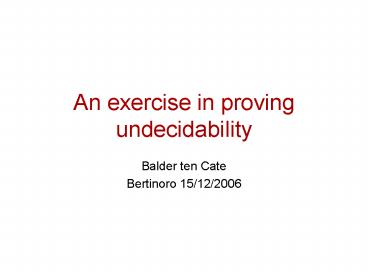An exercise in proving undecidability - PowerPoint PPT Presentation
Title:
An exercise in proving undecidability
Description:
An exercise in proving undecidability Balder ten Cate Bertinoro 15/12/2006 Query answering under GAV mappings Input: a GAV mapping m: S T a source instance I a ... – PowerPoint PPT presentation
Number of Views:48
Avg rating:3.0/5.0
Title: An exercise in proving undecidability
1
An exercise in proving undecidability
- Balder ten Cate
- Bertinoro 15/12/2006
2
Query answering under GAV mappings
- Input a GAV mapping m S?T
- a source instance I
- a target query ?
- Output the certain answers
- ?(I,J) m J(?)
3
Complexity
- For conjunctive queries ?, the problem is in
LOGSPACE (by unfolding) - For FO queries ?, its undecidable.
- This talk There a fixed FO query ? for which
computing the certain answers is undecidable.
(Corrolary CERT(m, ?) is not definable in
FO/datalog/...)
4
More precisely
- Fact There is a GAV mapping m S?T and a Boolean
FO query ? over T such that the following is
undecidable - Given a source instance I, is Yes a certain
answer to ? ? - Proof by reduction from an undecidable tiling
problem.
5
Periodic tiling
- An undecidable problem
- Given a finite set of tile types
- Can we tile any n ? n square with these tiles so
that (a) neighboring tiles match, (b) the first
and last column coincide, and (c) the first and
last row coincide (n gt 1) ?
...
6
Reduction to GAV answering
- Basic idea
- The source instance I specifies the set of tile
types - The GAV mapping m (which is fixed) simply copies
all the information - The FO query ? (which is fixed) describes a
periodic tiling with the given tile types. - Yes is a certain answer to ?? on source
instance I iff the set of tile types specified by
I admits no periodic tiling.
7
First attempt
- Source schema
- A unary relation TT listing tile types
- Binary relations COMPH and COMPV specifying
horizontal and vertical compatibility - The GAV mapping
- ?x (TTx ? TTx)
- ?x (RHx ? RH x)
- ?x (RVx ? RV x)
- Before we continue
- What is wrong with this attempt?
8
Bug fix
- We need to make sure that ...
- no compatibilities are added in the target
- Solution represent incompatibilities
- no new tile types are added in the target
- Solution use extra relations so that tampering
can be detected
9
The correct reduction
- Source schema
- A unary relation TT listing tile types
- Binary relations INCOMPH and INCOMPV specifying
horizontal and vertical incompatibility - Two binary relations coding a linear ordering of
the tile types and a corresponding successor
relation. - The GAV mapping copies everything (as before)
- The target query ? describes a periodic tiling
using the given tile types (homework exercise,
for the solution see Börger- Grädel-Gurevich) .
10
Added in print
- Prof. Kolaitis found a simpler and more elegant
proof by reduction of the undecidable embedding
problem for finite semi-groups given a partial
binary function, can it be extended to a
semi-group (over a possible larger but finite
carrier set)? - Source schema a single ternary relation R
- Target schema a single ternary relation R
- GAV mapping ?xyz (Rxyz ? Rxyz)
- The target query ? expresses that R is an
associative total function (this can be expressed
in FO logic, even using only ??-formulas). - Yes is a certain answer to ?? on source
instance I iff the I(R) cannot be extended to a
finite semi-group.































